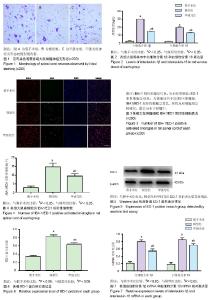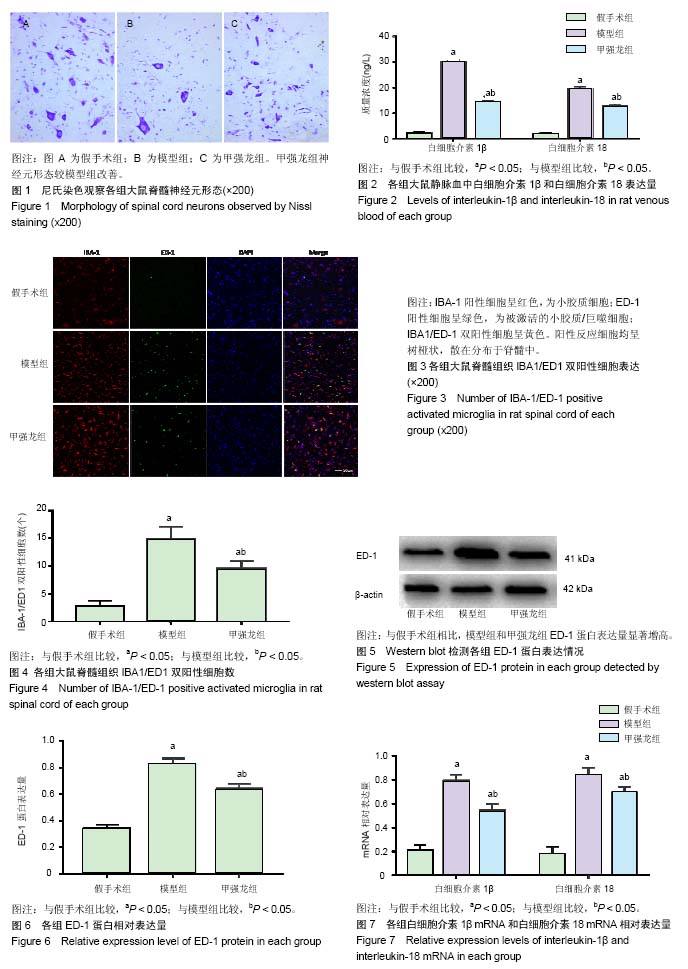| [1] 高永良,李琰.脊髓损伤的药物治疗进展[J]. 浙江创伤外科. 2013, 18(1):141-144.[2] 孙祥耀,海涌.脊髓损伤非手术治疗的研究进展[J]. 中国骨与关节杂志, 2016, 5(6):437-443.[3] Alvismiranda HR,Alcalacerra G, Moscotesalazar LR.Microglia: roles and rules in brain traumatic injury. Romanian Neurosurgery. 2013;20(1):34-45.[4] Wolf SA, Boddeke HW, Kettenmann H.Microglia in Physiology and Disease.Annu Rev Physiol. 2017;79:619-643.[5] 张立志,张志成,李放,等.甲基强的松龙在围手术期“大剂量冲击疗法”以外的应用[J].中国脊柱脊髓杂志, 2018(2):188-192.[6] Chen WF, Chen CH, Chen NF, et al. Neuroprotective Effects of Direct Intrathecal Administration of Granulocyte Colony‐Stimulating Factor in Rats with Spinal Cord Injury. CNS Neurosci Ther. 2015;21(9):698-707.[7] 孟珂, 蒲玉洁,张晓明.小胶质细胞与脊髓损伤关系的研究进展[J].中国临床解剖学杂志,2017;35(4):478-9.[8] 万峪岑,孙师,赵利娜,等.小剂量超短波治疗对大鼠脊髓损伤后炎症反应及水肿的影响[J]. 中国康复理论与实践, 2016, 22(2): 150-155.[9] Zhou X, He X, Ren Y. Function of microglia and macrophages in secondary damage after spinal cord injury. Neural Regen Res. 2014;9(20):1787-1795.[10] Greenhalgh AD , David S. Differences in the Phagocytic Response of Microglia and Peripheral Macrophages after Spinal Cord Injury and Its Effects on Cell Death. J Neurosci. 2014;34(18):6316-6322.[11] Xu J, Xq E, Liu H Y, et al. Angelica Sinensis attenuates inflammatory reaction in experimental rat models having spinal cord injury. Int J Clin Exp Pathol. 2015; 8(6):6779-6785.[12] Peng M , Wang Y L , Wang C Y , et al. Dexmedetomidine attenuates lipopolysaccharide-induced proinflammatory response in primary microglia. J Surg Res. 2013;179(1): e219-25.[13] Guglielmetti C, Le Blon D, Santermans E, et al. Interleukin-13 immune gene therapy prevents CNS inflammation and demyelination via alternative activation of microglia and macrophages. Glia. 2016;64(12):2181-2200.[14] Swaroop S, Sengupta N, Suryawanshi AR , et al. HSP60 plays a regulatory role in IL-1β-induced microglial inflammation via TLR4-p38 MAPK axis. J Neuroinflammation. 2016 Feb 2;13:27. [15] Tang Y,Le W.Differential Roles of M1 and M2 Microglia in Neurodegenerative Diseases. Mol Neurobiol. 2016;53(2): 1181-1194.[16] Liddelow SA, Guttenplan KA, Clarke L E, et al. Neurotoxic reactive astrocytes are induced by activated microglia. Nature.2017; 541(7638):481-487.[17] Abdanipour A,Tiraihi T,Taheri T, et al. Microglial activation in rat experimental spinal cord injury model. Iran Biomed J. 2013;17(4):214-220.[18] Mcgeer PL,Mcgeer EG.Targeting microglia for the treatment of Alzheimer's disease.Glia.2016; 64(10):1710-1732.[19] Tewari M, Monika, Varghese RK, et al. Astrocytes mediate HIV-1 Tat‐induced neuronal damage via ligand‐gated ion channel P2X7R. J Neurochem. 2015;132(4):464-476.[20] Bracken MB.Steroids for acute spinal cord injury. Cochrane Database Syst Rev. 2002;(3):CD001046.[21] 徐静磊.甲强龙与葛根素联用在预防急性脊髓缺血再灌注损伤中的疗效探讨[D]. 郑州:郑州大学,2013.[22] 俞勇,陈明,杜利娜.甲强龙对环扎法所致大鼠脊髓损伤后神经细胞凋亡的相关性研究[J].临床和实验医学杂志, 2016, 15(16): 1559-1561.[23] 杨新明,成垚昱,张振梁,等.甲强龙在骨髓间充质干细胞治疗大鼠脊髓损伤中的作用及对肿瘤坏死因子-α和白细胞介素-1β表达的影响[J].中国医学科学院学报,2017,39(05):615-622.[24] Liu JT, Zhang S, Gu B, et al.Methotrexate combined with methylprednisolone for the recovery of motor function and differential gene expression in rats with spinal cord injury. Neural Regen Res. 2017;12(9):1507-1518.[25] 成垚昱,杨新明,张振梁,等.大剂量甲强龙在BMSC移植治疗大鼠脊髓损伤中的作用[J].山东医药,2017, 57(21):13-16. |

